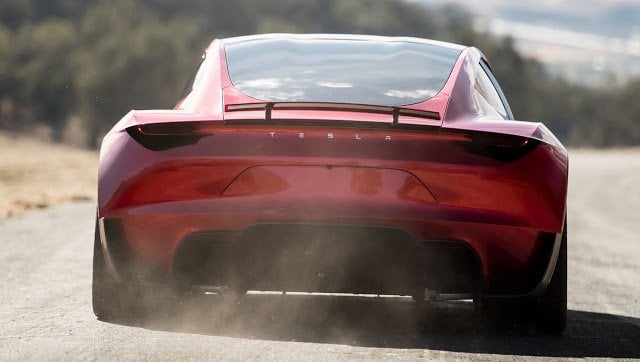During the annual Tesla shareholder meeting, CEO Elon Musk announced that Roadster 2020 would have a SpaceX option package that will include rocket thrusters. Later, Musk tweeted a few more details: the thrusters won’t actually combust; instead, they will expel high-pressure air to give the Tesla an extra boost of acceleration.
Industry experts and the tranche of the internet that follows Musk have been speculating and arguing about these rocket thrusters since their announcement. Will they be functional, whimsical and decorative (just there to signal your extravagance), or some combination of all of the above?
SpaceX’s Falcon 9 rockets use composite overwrapped pressure vessels (COPV). These tanks are made out of a thin metal liner wrapped in carbon fiber, and they’re fairly lightweight and a great way to store a lot of pressurized air in a very small space. This is what Tesla plans to use in the Roadster. Using COPVs in vehicles is not a new idea; some buses and trucks use them to store compressed natural gas, and fuel cell vehicles use COPVs to store hydrogen, but the gases in these tanks are used as fuel for the vehicles, not expelled as direct thrust.
Problems With Air As Thrust
When someone talks about putting an air rocket thruster on a car, the easy assumption is that these “thrusters” would be used for thrust by ejecting air and propelling the car. The experts have brought up many problems that this could cause:
- To accelerate a vehicle in the weight category of the new Tesla Roadster, the air would need to be expelled at super high speeds. Some have calculated that the air would need to exit at more than 1,500 mph to accelerate the Roadster. Using this at a stoplight could propel debris into the windshield of another car or a nearby pedestrian. If implemented this way, this potential hazard could prevent the thrusters from being street legal.
- Expelling air at high speeds would be exceptionally loud.
- Repressurizing the tank with the large volumes of air this would use a lot of energy from the battery pack.
Sam Abuelsamid, a senior research analyst at Navigant, an advisory firm for the auto industry, told The Verge, “It’s the most ridiculous thing I’ve ever heard of.”
Perhaps Tesla engineers have discovered ways to avoid all of these issues or perhaps they have something else in mind. Patent number 9,272,595 B2, issued to Tesla, might give us a hint to the real intentions that Tesla has for these “rocket thrusters.”


Tesla Patent
The patent is titled “Passive air bleed for improved cooling systems.” Have you ever used a can of air spray to clean your keyboard or blow dust out of your computer? If you have, you may have noticed that the can gets cold and might even frost over. The can gets cold due to a thermodynamics property known as adiabatic cooling. A gas, initially at high pressure, cools significantly when that pressure is released. Tesla’s patent uses this property to make a better cooling system.
Hot Lap, Overheating At The Track
Tesla does not make slow cars. They are known for their impressive zero to 60 and quarter-mile times. The performance demands of a hot lap are, however, very different from those of a 0-60.
When attempting a hot lap in a Model S, Car and Driver found multiple problems with the car. At the Virginia International Raceway, the Model S went into reduced power mode in the middle of its first hot lap. In the Tesla racing community, it is common knowledge that the Model S has issues on extended runs at the race track. One of the more well-known examples was when a Model S was unable to maintain full power through the mountainous “The Green Hell” Nordschleife section of the Nürburgring.
Unlike the Model S, the new Roadster will be a track car. It will be in the hypercar performance range. It will need better cooling of the high-power electronics and batteries.
Would Adiabatic Cooling Work?
Now that we know the problem the Roadster designers are trying to solve, let’s look at this potential solution and see how it fits with Musk’s rocket thrusters tweet.

The tweet says it will improve acceleration, top speed, braking, and cornering. Certainly, all of these things rely upon cooling. With acceleration and sustained top speed, the high voltage systems and batteries need to be cooled to prevent power reduction. With braking, the brake pads need to be cooled. In normal driving, an EV can use regenerative braking; this is not the case at the track. Hard braking when heading into a turn requires the friction brakes. Corner after corner can take its toll and really heat the brakes.
Cooling With a Side of Downforce
If cooling, not thrust, really is the primary function, these thrusters would not, necessarily, be on the back of the car. But once you have them, they can supply some thrust, so how could it best be utilized? Since cornering and acceleration require traction, the most likely place to put them is over the tires. Here, a small amount of downforce could affect performance significantly. Allowing the tires to stick to the road allows the torque of the electric motors to be used to its fullest.
How this could help allow a Tesla to fly, I’m not sure, maybe a couple of the thrusters will point down. Maybe Musk meant figuratively flying, as in going fast. Maybe he was actually just joking. Musk did say there would be ten of the thrusters. Perhaps two over each wheel and two pointing at the ground. If there are some pointing at the ground, I just hope the button to activate the fly feature on the touchscreen looks like this:

500 points to the first commenter to identify this.
TMC Member Patrick0101 is a solar and electric vehicle advocate who blogs at Cars With Cords.
